The School of Geography, Earth and Environmental Sciences has a wide range of high quality research microscopes designed for studying a variety of geological and palaeontological materials. The majority of the research quality microscopes are housed in Earth Sciences and are produced by Zeiss giving optimal changeability of parts between models.
Key equipment
 Zeiss Axioplan 2
Zeiss Axioplan 2
This is the best optical microscope for geological thin section work and includes both polarised and reflected light setups and lenses. A range of lenses are available for a range of transmitted, reflected and polarised light illumination. This system is normally used with the image capture from the Micro-imager digital camera that normally resides on the microscope, but can be changed to digital SLR when needed.
Zeiss Stero-Discovery V8
This new addition is optimised for palaeobotany and analysis of wafered sections and peels of 3-dimentional plant fossils. It has a LED transmitted light base for even illumination of specimens and also has fibre optic illuminators. Along with all the usual refinements it has a rotatable nosepiece with a 0.3 x, 0.5 x and 1 x objectives. The objectives are excellent and it has high quality image output.
Zeiss Axioscope
The Axioscope is used for analysis of microvertebrates and also geological thin section analysis. It has polarised light and a Nomarski differential interference with objectives up to 40 x. This is routinely used with the Q-Imager digital camera and is often used for image analysis work.
Zeiss Axioskop 40
This system has two different setups that can be readily changed as required. The majority of the time this scope is dedicated to palynological research using darkfield and phase contrast illumination. Objectives range from 1 x for large field observations and up to x 100 oil immersion lenses for detailed observation of palynomorphs. This setup can be readily changed into a fluid inclusion microscope with a heating/cooling stage and long working distance objectives by changing the condenser, stage and lenses.
 Zeiss Tessovar
Zeiss Tessovar
Although made in the 1960’s, the Tessovar is hard to beat optically as it provides a depth of field not achievable in conventional microscopes. Now that it has been adapted to fit the digital SLR bodies it provides unrivalled photographic images, and is most often used for specimens that are too large for binocular microscopes but too small for conventional macro-photography. The Tessovar can be adapted for specific purposes including transmitted and or reflected light illumination, and has both ring lights and fibre optic spot illuminators. It also has a dedicated computer with large monitor for image capture. It’s a beast that modern microscopes simply can’t match.
Zeiss Stemvi microscopes (3 available). These are the work horses of the facilities and include a range of objective lenses and eyepieces for different magnifications, and also include a transmitted light base, geological polarising system, camera-lucida drawing tube and photographic output.
Zeiss Florescence microscope
This microscope provides florescence illumination on specimens and is regularly used for observing and recording lamina within stalagmites and other seasonally laminated lithologies. This system is surrounded by light excluding curtains.
Nikon Ophiophot CL microscope
This microscope is dedicated for cathode-illumination and has digital output via Nikon Coolpix cameras.
In addition to these photo-scopes, a number of other microscopes are available for routine microscope observations
Image output
Digital still output
Each microscope is compatible with Canon Digital SLR cameras for high quality image capture. This provides high quality single frame output ideal for illustrative and publication purposes and has proven ideal for use in serial section reconstruction purposes.
In addition each microscope is compatible with Nikon Coolpix digital cameras range using special adaptors. Two of these systems are available.
Digital ccd output
All of the microscopes are compatible with Q-Imager micropublisher ccd digital cameras through conventional c-mount adaptors. At present two of these digital cameras are available, a 3 mega-pixel and a 5 mega-pixel version. Both integrate with Image-pro image analysis software that is available in the school.
Film output
In addition to the digital outputs listed above, each camera is compatible with conventional film that are available for use.
To use any of these facilities, please contact Aruna Mistry or Guy Harrington.